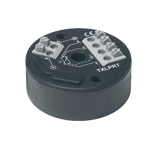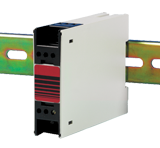Temperature Transmitters: A Guide to choosing the correct Temperature Transmitter
What is a Temperature Transmitter?
A temperature transmitter is a device that converts the analog output signal from a temperature sensor, typically a thermocouple or RTD (Resistance Temperature Detector) Pt100, into a standard and easily readable value. These transmitters convert thermocouple or RTD signals into various outputs, including 4-20 mA, 0-5 V, or to digital protocols like HART. They are available as either head mounting (at the end of a sensor) or DIN rail mounted with a wide range of features as shown below:
Popular Thermocouple and RTD Transmitters
Thermocouple Transmitter - Linearised Head Mounting
 Linearised head mount thermocouple transmitter
Linearised head mount thermocouple transmitter
RTD Pt100 Linearised Head Mounting Transmitter
 Linearised head mount Pt100 transmitter
Linearised head mount Pt100 transmitter
Universal Input Fully Isolated Head Mounting Transmitter
 Linearised & isolated head mount transmitter with universal input
Linearised & isolated head mount transmitter with universal input
Universal Input Slimline DIN Rail Mounting Transmitter
 Linearised & isolated slimline DIN Rail mount transmitter with universal input
RTD Pt100 Slimline DIN Rail Mounting
Transmitter
Linearised & isolated slimline DIN Rail mount transmitter with universal input
RTD Pt100 Slimline DIN Rail Mounting
Transmitter
 Llinearised Slimline DIN Rail mounted Pt100 Transmitter
High Precision DIN Rail
Llinearised Slimline DIN Rail mounted Pt100 Transmitter
High Precision DIN RailVoltage/Current Output
Thermocouple Transmitter
 Linearised & isolated slimline DIN Rail Voltage/Current output thermocouple transmitter
High Precision DIN Rail
Linearised & isolated slimline DIN Rail Voltage/Current output thermocouple transmitter
High Precision DIN RailVoltage/Current Output
RTD Pt100 Transmitter
 Linearised & isolated slimline DIN Rail Voltage/Current output RTD Pt100 transmitter
HART Protocol Thermocouple and RTD Transmitter Head Mounted
Linearised & isolated slimline DIN Rail Voltage/Current output RTD Pt100 transmitter
HART Protocol Thermocouple and RTD Transmitter Head Mounted
 Head mounting transmitters that can be set by a HART communicator or other HART related software.
HART Protocol Thermocouple and RTD Transmitter DIN Rail Mounted
Head mounting transmitters that can be set by a HART communicator or other HART related software.
HART Protocol Thermocouple and RTD Transmitter DIN Rail Mounted
 DIN Rail mounting transmitters that can be
set by a HART communicator or other HART related software.
ATEX Approved Thermocouple and RTD Transmitter Head Mounted
DIN Rail mounting transmitters that can be
set by a HART communicator or other HART related software.
ATEX Approved Thermocouple and RTD Transmitter Head Mounted  ATEX approved head mounting transmitters, ideal for a wide range of applications where ATEX approval is required.ATEX Approved Thermocouple and RTD Transmitter DIN Rail Mounted
ATEX approved head mounting transmitters, ideal for a wide range of applications where ATEX approval is required.ATEX Approved Thermocouple and RTD Transmitter DIN Rail Mounted ATEX approved DIN Rail mounting transmitters, ideal for a wide range of ATEX approved applications.Thermocouple and RTD Transmitter DIN Rail Voltage/ Current Output with Display
ATEX approved DIN Rail mounting transmitters, ideal for a wide range of ATEX approved applications.Thermocouple and RTD Transmitter DIN Rail Voltage/ Current Output with Display Provides a 0-10V DC, 0-1V DC, 4-20mA or 0-20mA output signal with display
RTD Transmitter DIN Rail Voltage/Current Output Thermocouple with Display
Provides a 0-10V DC, 0-1V DC, 4-20mA or 0-20mA output signal with display
RTD Transmitter DIN Rail Voltage/Current Output Thermocouple with Display Isolated DIN Rail mounting transmitter that provides a 0-10V DC, 0-1V DC, 4-20mA or 0-20mA output signal with display
Thermocouple and RTD DIN Rail Mounting Transmitter
Isolated DIN Rail mounting transmitter that provides a 0-10V DC, 0-1V DC, 4-20mA or 0-20mA output signal with display
Thermocouple and RTD DIN Rail Mounting Transmitter Microprocessor based, high accuracy, scaleable DIN Rail mounting transmitters
Low Cost Thermocouple and RTD DIN Rail Mounting Transmitter
Microprocessor based, high accuracy, scaleable DIN Rail mounting transmitters
Low Cost Thermocouple and RTD DIN Rail Mounting Transmitter Low cost DIN Rail mounting transmitters
Low cost DIN Rail mounting transmitters
How Do Temperature Transmitters Work?
Temperature transmitters work by taking the analog signal generated by a temperature sensor (emf for a thermocouple or resistance for an RTD) and converting it into a standardised output. A simplified explanation of the process is detailed below:
Signal Acquisition: The transmitter collects the voltage or resistance signal from the temperature sensor.
Signal Conditioning: It then processes and conditions the signal (e.g. cold junction compensation for thermocouples) to ensure accuracy and stability.
-
Output Signal Generation: The transmitter generates a standardised output signal, such as 4-20 mA, or 0-5Vdc which is proportionate to the temperature measurement. For example, the transmitter can be programmed to give a linearised 4-20mA output over a range of 0ºC to 100ºC where 4mA represents 0ºC and 20mA represents 100ºC.
-
Signal Transmission: This standardised output signal can then be transmitted over long distances (useful for thermocouple signals to eliminate volt drop errors) as part of a 2 wire loop to instrumentation, data loggers, temperature controllers or PLCs.
Applications for Temperature Transmitters
Temperature transmitters are used for various applications in a wide range of industries, including:
-
Industrial Processes: For precise temperature control and monitoring in manufacturing and chemical processes.
HVAC Systems: To monitor and regulate heating, ventilation, and air conditioning systems.
-
Scientific Research: In laboratories and scientific experiments.
Energy Management: In energy-efficient and cost-effective temperature control solutions.
Petrochemical / Oil and Gas: ATEX approved transmitters are available for a wide range of uses within the Oil and Gas Industry.
Summary
Temperature transmitters play a pivotal role in maintaining accurate temperature measurement and control in various industries. Their ability to convert sensor signals into standardised outputs, along with their many features and benefits, makes them an essential component in temperature management systems.
For more information on temperature transmitters, specific applications, or assistance in choosing the right transmitter for your application, please contact one of our experienced engineers on 01895 252222 or use the Live Chat button.
Need advice on choosing a temperature transmitter?
Contact one of our experienced engineers on
01895 252222 or use the Live Chat button.

 France
France Germany
Germany Spain
Spain Netherlands
Netherlands Italy
Italy Hungary
Hungary United States
United States Australia
Australia